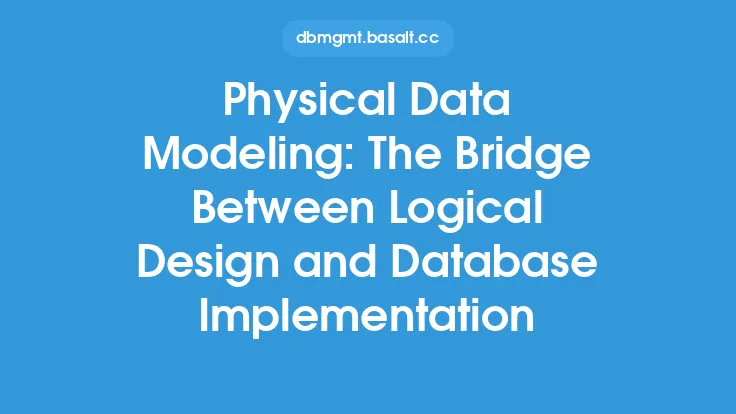When designing a database, one of the primary goals is to create a structure that is both efficient and scalable. To achieve this, database administrators and developers often employ various data modeling techniques, including denormalization. Denormalization is the process of intentionally deviating from the principles of normalization to improve the performance of a database. In this article, we will delve into the world of denormalization and data modeling, exploring the concepts, benefits, and best practices of denormalization, as well as its role in creating an optimal database structure.
Introduction to Denormalization
Denormalization is a technique used to optimize database performance by reducing the number of joins required to retrieve data. In a normalized database, each piece of data is stored in one place and one place only, which can lead to complex queries and slower performance. Denormalization involves duplicating data or storing it in a way that is not fully normalized, which can improve query performance but may also lead to data inconsistencies and increased storage requirements. There are several types of denormalization, including data duplication, summary tables, and pre-aggregated data.
Data Modeling and Denormalization
Data modeling is the process of creating a conceptual representation of the data in a database. It involves identifying the entities, attributes, and relationships between them. When creating a data model, it is essential to consider the trade-offs between normalization and denormalization. Normalization is the process of organizing data in a database to minimize data redundancy and dependency, while denormalization is the process of intentionally deviating from these principles to improve performance. A good data model should balance the need for data consistency and integrity with the need for high performance and scalability.
Types of Denormalization
There are several types of denormalization, each with its own benefits and drawbacks. Data duplication involves storing the same data in multiple places, which can improve query performance but may lead to data inconsistencies. Summary tables involve storing pre-aggregated data, which can improve query performance but may require additional storage space. Pre-aggregated data involves storing data in a way that is already aggregated, which can improve query performance but may require additional maintenance. Other types of denormalization include data partitioning, data indexing, and materialized views.
Benefits of Denormalization
Denormalization can offer several benefits, including improved query performance, reduced storage requirements, and increased scalability. By reducing the number of joins required to retrieve data, denormalization can improve query performance and reduce the load on the database. Denormalization can also reduce storage requirements by storing data in a more compact form. Additionally, denormalization can increase scalability by allowing the database to handle more users and queries.
Best Practices for Denormalization
While denormalization can offer several benefits, it is essential to follow best practices to ensure that the database remains consistent and scalable. One of the most important best practices is to carefully evaluate the trade-offs between normalization and denormalization. It is also essential to consider the data model and the types of queries that will be run against the database. Additionally, it is crucial to monitor the database's performance and adjust the denormalization strategy as needed. Other best practices include using data duplication judiciously, creating summary tables and pre-aggregated data, and using data partitioning and indexing to improve query performance.
Common Denormalization Techniques
There are several common denormalization techniques used in database design. One of the most common techniques is data duplication, which involves storing the same data in multiple places. Another technique is summary tables, which involve storing pre-aggregated data. Pre-aggregated data is another technique, which involves storing data in a way that is already aggregated. Data partitioning is also a common technique, which involves dividing the data into smaller, more manageable pieces. Additionally, data indexing and materialized views are also used to improve query performance.
Denormalization and Data Integrity
One of the primary concerns with denormalization is data integrity. When data is duplicated or stored in a way that is not fully normalized, there is a risk of data inconsistencies and errors. To mitigate this risk, it is essential to implement data integrity checks and constraints, such as primary keys, foreign keys, and check constraints. Additionally, it is crucial to monitor the database's performance and adjust the denormalization strategy as needed. Regular backups and data validation are also essential to ensure data integrity.
Denormalization and Database Scalability
Denormalization can play a crucial role in database scalability. By reducing the number of joins required to retrieve data, denormalization can improve query performance and reduce the load on the database. Additionally, denormalization can increase scalability by allowing the database to handle more users and queries. However, it is essential to carefully evaluate the trade-offs between normalization and denormalization and to consider the data model and the types of queries that will be run against the database.
Conclusion
In conclusion, denormalization is a powerful technique used to optimize database performance by reducing the number of joins required to retrieve data. While denormalization can offer several benefits, including improved query performance, reduced storage requirements, and increased scalability, it is essential to follow best practices to ensure that the database remains consistent and scalable. By carefully evaluating the trade-offs between normalization and denormalization, considering the data model and the types of queries that will be run against the database, and implementing data integrity checks and constraints, database administrators and developers can create an optimal database structure that balances the need for data consistency and integrity with the need for high performance and scalability.





